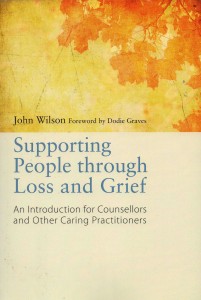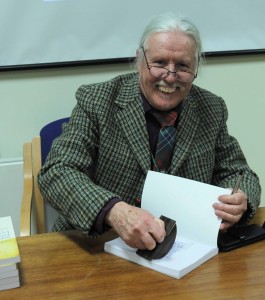Why this book was needed
In the last decade of the twentieth century, a team of experts in the fast-growing field of bereavement support, came together to produce a teaching pack. The writers adopted a bereavement counselling approach to helping, and their ambitious project, entitled Bereavement Counselling: a 60 hour introductory training course, was published by Cruse Bereavement Care and Help the Hospices in 1998. This was the pack that was used to train me when in 1999 I joined the bereavement support team as a volunteer at Saint Catherine’s Hospice in Scarborough, UK. 6 months later I accepted a professional post in the service as a bereavement counsellor. Within a few years, perhaps due to my background as a teacher and lecturer, I was helping to teach my colleagues, also using Faulkner and Wallbank’s teaching pack. Of course, the knowledge base of bereavement theory does not stand still: On the contrary. Due to the outstanding contribution of Margaret Stroebe’s team at the University of Utrecht in the Netherlands, worldwide research into bereavement has been brought together in a series of research handbooks (2008; 2001; 1993). In my role as trainer, and with these weighty volumes by my side, I found I was constantly updating the content of our volunteer training, to the point that little remained of the 1998 teaching pack apart from its philosophy of experiential learning, which I have embraced throughout my teaching career.
Saint Catherine’s Hospice Bereavement Support Module
Over the past six years, my colleagues and I have developed a completely new module, moving from the 60 hour training of the original pack to a full module of 200 study hours, including two written assignments. The ideas of Faulkner and Wallbank that do remain in our teaching materials are duly credited and correctly referenced, as they are in the book. Our successful students have included counsellors and psychotherapists, social workers, palliative care nurses, health visitors, care home staff, teachers and chaplains. Many of our students go on to work with bereaved people. Supporting People through Loss and Grief is an extension of the teaching notes written and re-written over several years. We deliver our module at Saint Catherine’s Hospice, in Scarborough, UK, in September each year. The first two sessions are a Monday and Tuesday together, followed by 6 more Tuesdays, each two weeks apart. The book is an accurate reflection of the content of our module, which culminates with the two pieces of work, assessed work to university standards.
Writing from a position of knowledge: putting theory with practice
In the 15 years that I have been working with bereavement, I have listened to many hundreds of grieving people and assessed their needs, before going on to work with a significant number of those I initially assessed. Since 2009 I have been engaged in planning a postgraduate research project at Saint Catherine’s Hospice, and in 2011 began a part-time PhD at York St John University. All this has given me a wide breadth of theoretical understanding which I feel, complements my practical experience.
Writing the book
The publishers, Jessica Kingsley accepted my proposal to write this book in June 2012 and the manuscript was completed in June 2013, around three weeks early. This meant that the book was released in December 2013, ahead of the originally planned January 2014. I had sent drafts to some of the notable experts in the field, and two of the ‘greats’ wrote reviews which appear on the back cover.
Dr. Colin Murray Parkes, psychiatrist, researcher and author of many books on bereavement who had kindly checked over the chapters on attachment theory, wrote:
“Comprehensive, well-researched and easy to read.”
Margaret Stroebe, Ph.D., Professor, University of Utrecht and University of Groningen, The Netherlands. Co-editor of ‘Handbook of Bereavement: Research and Practice’ and ‘Complicated Grief: Scientific Foundations for Health Care Professionals’, wrote:
“In this highly accessible, well-written book, John Wilson shares not only the breadth of his academic scholarship but also his extensive experience and personal wisdom as a bereavement counselor. One becomes aware of the author’s passionate concern to inform and advise us; he is at heart a teacher. But what also makes his volume so valuable is his way of challenging our set beliefs, even our knowledge base: The reader must decide , we are told at one point. This way, we are drawn to reflect and to reread classic books and articles with fresh eyes. We stand to learn a great deal, even beyond the knowledge provided in these pages. It is a most valuable addition to the literature for researchers and bereavement supporters alike.”
My friend and colleague Dodie Graves, another Jessica Kingsley author; of ‘Talking with Bereaved People’ and ‘Setting Up and Facilitating Bereavement Support Groups ‘, was kind enough to write the foreword to the book. Here is an extract:
“If you are looking for help in training volunteers for a bereavement service, you will be greatly supported by the content of this book which could help you formulate your sessions and provide guidance along the way. If you are a counsellor, or professional care practitioner, wishing to enhance your understanding of loss and grief as you work with bereaved people you will find much to help you in these pages. There is wisdom and a wealth of good practice here, and I have learnt much along the way from someone who is a good, safe pair of hands.”
Look inside the book
The Amazon UK webpage for the book allows you a preview. You can find the link HERE
The Amazon.com page is HERE
My hope is that this book becomes a course reader wherever in the world bereavement workers are trained, that trainers worldwide will come to adopt this book, and that counsellors seeking to learn more about this field will add it to their bookshelf. All the royalties from this edition will go to patient care at the hospice from which my experience and inspiration originates.
The picture below is taken by my colleague Kath Atherton, at a book signing event in
January 2014


